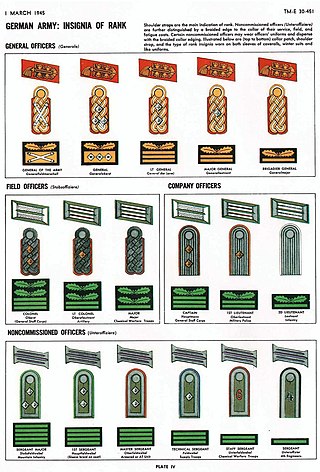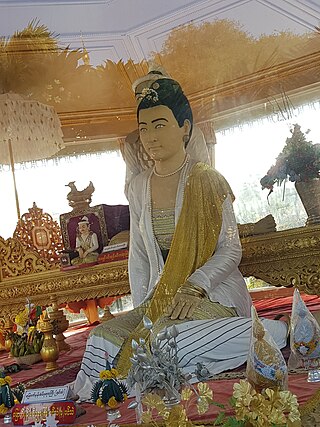
Epaulette is a type of ornamental shoulder piece or decoration used as insignia of rank by armed forces and other organizations. Flexible metal epaulettes are referred to as shoulder scales.

Upanayana is a Hindu educational sacrament, one of the traditional saṃskāras or rites of passage that marked the acceptance of a student by a preceptor, such as a guru or acharya, and an individual's initiation into a school in Hinduism. Some traditions consider the ceremony as a spiritual rebirth for the child or future dvija, twice born. It signifies the acquisition of the knowledge of and the start of a new and disciplined life as a brahmāchārya. According to the given community and its regional language, it is also known by numerous terms such as mekhal in Kashmiri (मेखल), janeo in Punjabi (ਜਨੇਓ), upnen/upvit in Rajasthani (उपनेन/उपवीत), jānoi in Gujrati (જાનોઇ), janya in Sindhi (जन्य), janev in Bhojpuri (जनेव), munja in Marathi (मुंजा), munji in Konkani (मुंजी), poite in Bangla (পৈতৈ), brataghara in Odia (ବ୍ରତଘର), logun dioni in Assamese, bratabandha in Nepali (ब्रतबन्ध), chewar in Newari (छेवार), upanayana in Kannada (ಉಪನಯನ), upanayanamu in Telugu (ఉపనయనము), upanayanam in Malayalam (ഉപനയനം), and upanayanam or pūṇūl in Tamil. The Upanayanam ceremony is arguably the most important rite for Brāhmaṇa, Kṣatriya, and Vaiśya males, ensuring his rights with responsibilities and signifying his advent into adulthood.

Busby is the English name for the Hungarian prémes csákó or kucsma, a military head-dress made of fur, originally worn by Hungarian hussars. In its original Hungarian form the busby was a cylindrical fur cap, having a bag of coloured cloth hanging from the top. This bag could be filled with sand and the end attached to the right shoulder as a defence against sabre cuts.

The Konbaung dynasty, also known as the Third Burmese Empire (တတိယမြန်မာနိုင်ငံတော်), was the last dynasty that ruled Burma from 1752 to 1885. It created the second-largest empire in Burmese history and continued the administrative reforms begun by the Toungoo dynasty, laying the foundations of the modern state of Burma. The reforms, however, proved insufficient to stem the advance of the British Empire, who defeated the Burmese in all three Anglo-Burmese Wars over a six-decade span (1824–1885) and ended the millennium-old Burmese monarchy in 1885.

The Thiri Thudhamma Thingaha or the Order of Thiri Thudhamma was the highest Burmese commendation during the AFPFL era. In that day, Burmese orders could be also used as titles. Thiri Thudhamma Thingaha was founded on 2 September 1948. It is awarded in three classes:
- Agga Maha Thiri Thudhamma – Grand Commander
- Sado Thiri Thudhamma – Grand Officer
- Maha Thiri Thudhamma – Companion

The Mahamuni Buddha Temple is a Buddhist temple and major pilgrimage site, located southwest of Mandalay, Myanmar (Burma). The Mahamuni Image is enshrined in this temple, and originally came from Arakan. It is highly venerated in Burma and central to many people's lives, as it is seen as an expression of representing the Buddha's life.
Bihari is a demonym given to the inhabitants of the Indian state of Bihar. Bihari people can be separated into three main Indo-Aryan ethnolinguistic groups, Bhojpuris, Maithils and Magadhis. They are also further divided into a variety of hereditary caste groups. In Bihar today, the Bihari identity is seen as secondary to caste/clan, linguistic and religious identity but nonetheless is a subset of the larger Indian identity. Biharis can be found throughout India, and in the neighbouring countries of Nepal, Pakistan and Bangladesh. During the Partition of India in 1947, many Bihari Muslims migrated to East Bengal. Bihari people are also well represented in the Muhajir people of Pakistan because of Partition.
Bania is a mercantile caste mainly from the Indian states of Gujarat and Rajasthan, with strong diasporic communities in Uttar Pradesh, Madhya Pradesh, West Bengal, Maharashtra and other northern states. Traditionally, the main occupations of the community are merchants, bankers, money-lenders, and owners of commercial enterprises.

The 2011 census of India or the 15th Indian census was conducted in two phases, house listing and population enumeration. The House listing phase began on 1 April 2010 and involved the collection of information about all buildings. Information for National Population Register (NPR) was also collected in the first phase, which will be used to issue a 12-digit unique identification number to all registered Indian residents by Unique Identification Authority of India. The second population enumeration phase was conducted between 9 and 28 February 2011. Census has been conducted in India since 1872 and 2011 marks the first time biometric information was collected. According to the provisional reports released on 31 March 2011, the Indian population increased to 1.21 billion with a decadal growth of 17.70%. Adult literacy rate increased to 74.04% with a decadal growth of 9.21%. The motto of the census was Our Census, Our Future.

The Heer as the German army and part of the Wehrmacht inherited its uniforms and rank structure from the Reichsheer of the Weimar Republic (1921–1935). There were few alterations and adjustments made as the army grew from a limited peacetime defense force of 100,000 men to a war-fighting force of several million men.

Islam in Uttar Pradesh is the second largest religion in the state with 38,483,967 adherents in 2011, forming 19.26% of the total population. Muslims of Uttar Pradesh have also been referred to as Hindustani Musalman. They do not form a unified ethnic community, but are differentiated by sectarian and Baradari divisions, as well as by language and geography. Nevertheless, the community shares some unifying cultural factors. Uttar Pradesh has more Muslims than any Muslim-majority country in the world except Indonesia, Pakistan, Bangladesh, Nigeria, Egypt, Iran, Turkey, Iraq and Afghanistan.

Burmese royal titles are the royal styles that were in use by the Burmese monarchy until the disintegration of the last Burmese monarchy, the Konbaung dynasty, in 1885. These titles were exclusively used by those of royal lineage, or more formally, Maha Zi Maha Thwei (မဟာဆီမဟာသွေး).

Historically, women in Myanmar have had a unique social status and esteemed women in Burmese society. According to the research done by Mya Sein, Burmese women "for centuries – even before recorded history" owned a "high measure of independence" and had retained their "legal and economic rights" despite the influences of Buddhism and Hinduism. Burma once had a matriarchal system that includes the exclusive right to inherit oil wells and the right to inherit the position as village head. Burmese women were also appointed to high offices by Burmese kings, can become chieftainesses and queens.

The Royal Armed Forces were the armed forces of the Burmese monarchy from the 9th to 19th centuries. It refers to the military forces of the Pagan Kingdom, the Kingdom of Ava, the Hanthawaddy Kingdom, the Toungoo dynasty and the Konbaung dynasty in chronological order. The army was one of the major armed forces of Southeast Asia until it was defeated by the British over a six-decade span in the 19th century.

The makuṭa, variously known in several languages as makuta, mahkota, magaik, mokot, mongkut or chada, is a type of headdress used as crowns in the Southeast Asian monarchies of today's Cambodia and Thailand, and historically in Indonesia, Malaysia, Sri Lanka, Laos and Myanmar. They are also used in classical court dances in Cambodia, Indonesia, Malaysia, Sri Lanka and Thailand; such as khol, khon, the various forms of lakhon, as well as wayang wong dance drama. They feature a tall pointed shape, are made of gold or a substitute, and are usually decorated with gemstones. As a symbol of kingship, they are featured in the royal regalia of both Cambodia and Thailand.
The Wareru Dhammathat is one of the oldest extant dhammathats of Myanmar (Burma). It was compiled in the 1290s in Mon at the behest of King Wareru of Martaban. Modeled after the Hindu legal treatise Manusmriti, the Code expounds mostly Pagan era Burmese customary law; it contains less than 5% of the content of the Manusmriti.
Clothing in Myanmar varies depending on the ethnicity, geography, climate and cultural traditions of the people of each region of Myanmar (Burma). The most widely recognized Burmese national costume is the longyi, which is worn by both males and females nationwide. Burmese clothing also features great diversity in terms of textiles, weaves, fibers, colours and materials, including velvet, silk, lace, muslin, and cotton.

Thiri Mahamingala Thupabadewi, commonly known as the Laungshe Mibaya or Queen of Laungshe, was a royal princess and senior queen consort of King Mindon during the Konbaung dynasty. She was the queen mother of the Konbaung dynasty's last king, Thibaw Min. Being a cousin of King Mindon, she was promoted to a Nanzwe Mibaya and received the appanage of Laungshe when he ascended the throne.

Khin The, commonly known by her regnal title Thiri Maha Yadana Mingala Dewi, was the Queen of the Northern Palace of King Mindon Min during the Konbaung dynasty. Among several queen consorts, Khin The was the favored queen of King Mindon.

Seindon Mibaya, known by her royal title, Thiri Pobba Yadana Dewi, was a senior queen consort of King Mindon during the Konbaung dynasty. Being a cousin of King Mindon, she was promoted to a Nanzwe Mibaya and received the appanage of Seindon when he ascended the throne.

















